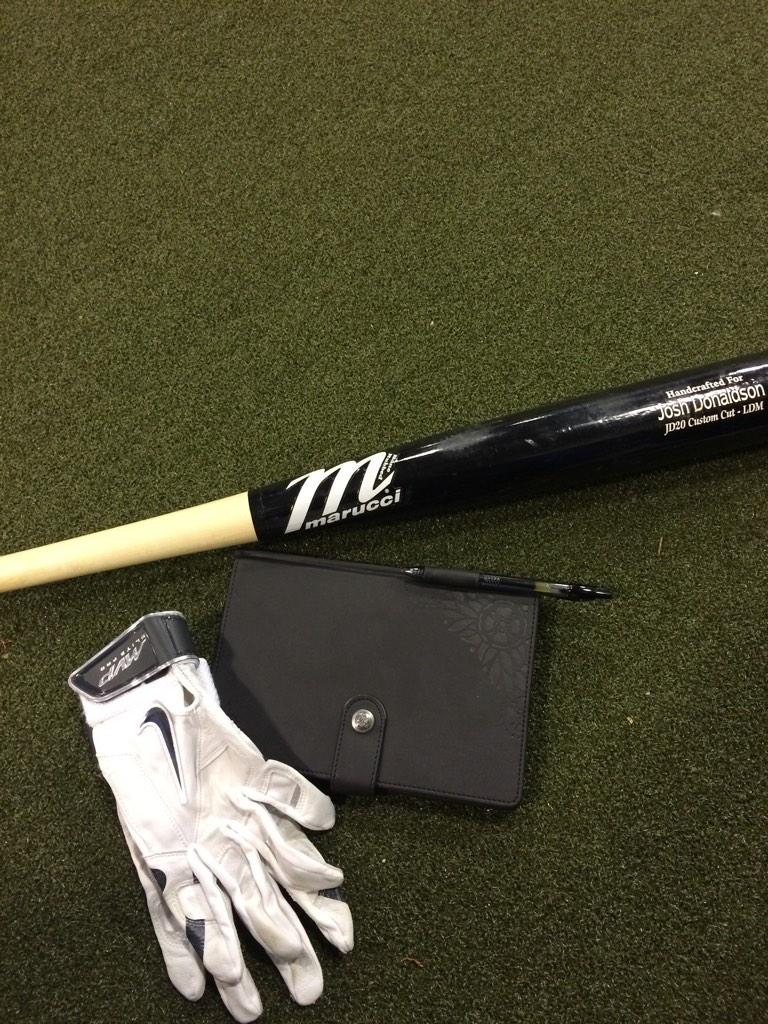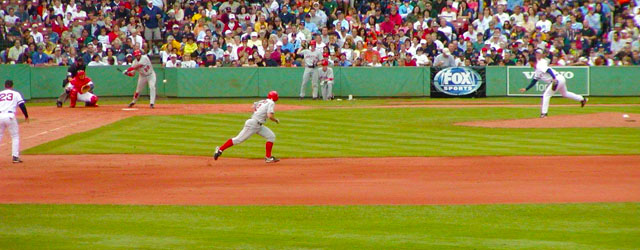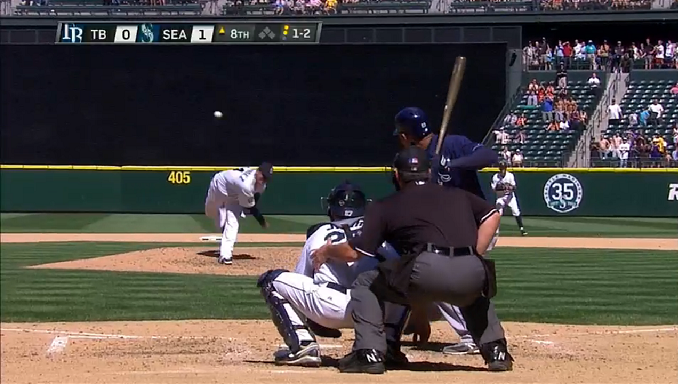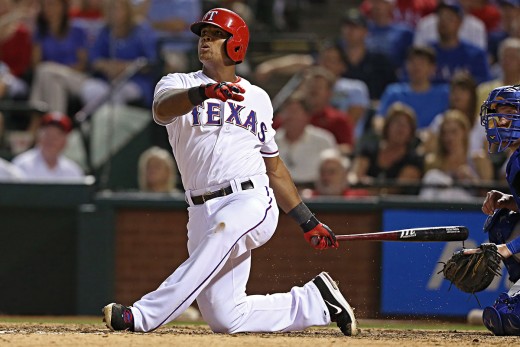(photo credit: worstswingever.com)
The linear hand path swing, long believed to be the "short swing," is actually the longest possible route to the ball. You heard that right.
Derek Jeter's hand path is a poor teaching tool to young players. Sure, it maximizes contact...much of that contact is weak contact. A linear hand path causes a steeper swing path that is most effective on pitches down in the zone. Pitches up in the zone, those that should be easiest to drive for extra base hits, are often swung through or fouled off.
Hitters with linear hand paths cannot achieve their maximum bat speed until the barrel releases at contact, rather than achieving max bat speed prior to contact, on a flat plane that enables multiple hard contact points, particularly on elevated pitches. Hitters that have linear hand paths must commit
sooner to swinging at pitches than do hitters with flatter swings. Those flatter swings are just as "short." We shall explain.
THE LOAD
First, let's start by establishing a truth: a good load does not mean you will have a good swing, but a bad load all but guarantees you a bad swing or poor contact.
The load is the most important part of the swing. It empowers balance, enables separation, creates momentum and maximizes bat speed and swing plane. That is the load.
***Note: for the purpose of this blog post, the term "load" is a simplification of both the load and stride. All movement before the front heel plants should be considered the load.
THE SWING
Let's define a "short" swing. A short swing has a tight path to the body. Envision your car driving on the inside lane of a NASCAR track vs. the outside lane. The outside lane has a further distance to travel. It is a
longer path. The same physics concept holds true for the swing. However, somewhere in the last century, a misunderstanding of swing-analysis created a pervasive and improper teach of the hand-path.
A linear hand path is a swing in which the hands pull the handle of the bat, tight to the body, leading the knob to the pitcher. Envision your bottom hand playing a violin, pulling down and forward towards the pitcher. This is a similar hand movement to the linear hand path swing. This hand path can maximize contact on pitches inside or outside, ensuring I hit the ball more frequently when not knowing, pre-swing commitment, if the pitch will be inside or outside.
Unfortunately, a hand-path that maximizes contact does not make a short swing. The back elbow staying tight to the rib cage does not guarantee a short swing, if said hand path is linear. Making contact is not the goal. Read that again. Making contact is not the goal.
Making
hard contact is the goal.
To make hard contact, we shouldn't create a swing that maximizes contact not knowing where the pitch is going to be. We should learn approaches and situational hitting, and teach myself a swing that maximizes hard contact. This is where Hitting Twitter has recently helped so many young hitters begin learning the proper mechanics to become an elite hitter.
Great follows on twitter for swing info:
@HyattCraig
@SaberCoach
@TewksHitting
@BringerofRain20
@CoachJeffLeach
@DavidRing4
@JWonCatching
(photo credit: m.reddit.com)
SWINGING AT TUNNELS
The concept of "swinging at tunnels" means that the flight path/plane/angle the ball is thrown from is the plane/angle at which I am trying to meet the baseball at contact.
This is simple when pitchers are throwing an average spin, four-seam fastball. There is a flat, somewhat gradual downward descent to the hitting zone. However, every other type of pitch offers a path/plane/angle that is different at contact than originally perceived by the eyes at release. Obviously, this is due to spin. Even a high-spin fastball, albeit a fastball, will stay at an angle more true/less steep than an average fastball, creating the deception of rising towards the hitting zone. Of course, off-speed pitches often have sink, cut, run, etc. and must be met at a different anticipated path/plane/angle that which they left the pitcher's hand.
I hypothesize that the creation of, and belief in, the linear hand path swing, stems from maximization of hitting pitches that change path/plane/angle from their original release point.
Hitters with this type of hand path will hammer fastballs middle down, middle in, middle away, and "zone" breaking balls that are elevated. These same hitters usually learn to "hit the ball up the middle", "stay gap to gap" and look for fastballs down the middle, trying to "adjust" in and out by staying through the ball or pulling their hands tighter to their body. This approach is the approach that matches the linear hand path. Approach matching a swing path is a good thing.
The bad thing about this dynamic duo of middle/middle approach linear swing path is that the majority of their outs are found pull side on the ground and opposite field in the air. These types of outs do not produce quality outs.
The ugly thing about this matched approach and hand path is what we discussed before in regards to lacking maximum bat speed, susceptibility to elevation, susceptibility to inside and outside corner pitches. The middle of the plate is covered, but these hitters are only mistake hitters. The holes in this type of a swing/approach combination are glaring. When facing a pitcher who can truly pitch, they have nothing with which to combat his pitchability. Fastballs on the inside part of the plate are impossibly tough to keep fair without getting beat, popping up or grounding out, and the early commitment caused by the swing path make these hitters extraordinarily susceptible to change ups.
Well, that's true for facing any great pitcher, you say? Au contraire.
The proper swing path hammers elevated pitches, and still hammers pitches down. It hits inside and outside pitches by having approaches/or timing and rhythm, that allow for coverage of those zones. Their approaches and swing combination allow them to better cover the elite pitchers. This is why the best hitters of each era, of all time, and those who maximize their personal talent, all have similar swing path mechanics. Look them up on YouTube: Babe Ruth, Hank Aaron, Barry Bonds, Miguel Cabrera, David Ortiz, Josh Donaldson, Russell Martin, Kevin Pillar. If you don't know who those last two are, turn on the the Blue Jays. They're pretty good.
And all of this isn't to say you can't be successful with a linear hand path swing! Dozens of Hall of Famers had linear hand paths, most notably: Tony Gwynn, Derek Jeter, Rod Carew, Lou Brock.
Notice these are all high contact hitters with average, below average power. Each of these hitters could have had above average power numbers with a different swing, thus improving their hard contacts, OPS, WAR and general offensive impact on their teams. They were
GREAT hitters. GREAT! But this does not mean they could not have been better. This does not mean we should teach their swings to all the little boys and girls in Little League, high school and college baseball.
Hitters who are extremely physical, with superior strength for their level, can get away with linear hand paths. They have the strength at contact to produce maximum ball carry while still hitting the ball deeper, or steeper, in their swing.
To read about the proper flat swing mechanics, read my blog post from July 20, 2014.
Keeping all of this in mind, approaches are more important than swings. Toughness and commitment are more important than swings. Yet, if we work so diligently at our craft, should we not pursue greatness in all areas?
We'll see you on the diamond. Be excellent.




















